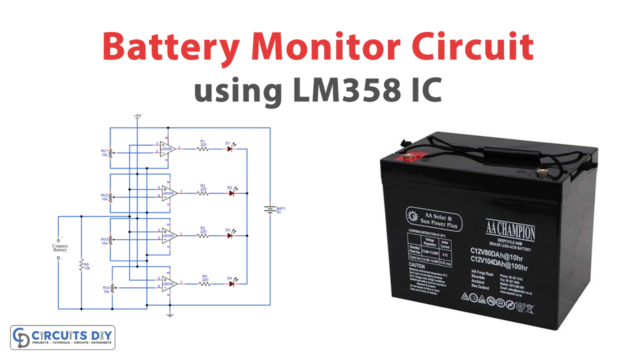Introduction:
The battery is a source of electrical energy used in many electronic devices in different forms. It converts chemical energy into electrical energy. Battery monitoring is a device that is used to monitor the status of the cells used in the battery, it indicates the low battery by monitoring the voltage of the battery. Battery monitoring is an essential part of several electronic devices that work on batteries, it helps in maintaining the batteries and prevents any major loss. It is also called a voltage monitor.
This circuit is simple and easy to build and can be used in cars to monitor the battery status. It uses an IC LM3914 as a voltage level indicator, the IC senses the level of voltages and displays it over LEDs. The working and circuit are explained below.

Hardware Components
The following components are required to make Battery Monitor Circuit
| S.no | Component | Value | Qty |
|---|---|---|---|
| 1. | IC | LM3914 | 1 |
| 2. | Variable Resistor | 5KΩ, 10KΩ, 200E | 1 |
| 3. | Battery | 12V | 1 |
| 4. | LED | 10 | |
| 5. | Resistor | 4.7KΩ, 1.2KΩ | 1 |
| 6. | Capacitor | 10μF/25V | 1 |
| 7. | Diode | 1N4001 | 1 |
LM3914 Pinout

For a detailed description of pinout, dimension features, and specifications download the datasheet of LM3914
Battery Monitor Circuit

Working Explanation
The circuit is easy to build, it uses variable resistors, LEDs and diode, capacitor, and IC LM3914 which is the main component of the circuit.
IC LM3914: This is a monolithic IC that senses the level of voltages and displays the levels using LEDs either in bar graph mode or dot mode. The brightness of LEDs indicates the different voltage levels. The IC takes analog voltage as input and drives the LEDs accordingly. The IC operates on the voltage range of 3-25V DC.
The circuit is designed in order to monitor the voltage of up to 12V lead-acid batteries. The voltage reading is set to 1.2V by variable resistor VR2. The 10K pot VR2 is used to adjust in a way that up to 10 LEDs glow. The resistors VR1 and VR3 are set at their middle values and when VR1 on its maximum value equals 4.5V, the circuit is then ready to be used as a battery monitor.
Applications
The battery monitoring circuit finds its applications in many devices.
- Mobile phones, tablets, and laptops have a battery monitoring circuit that shows the battery of the gadget.
- Chargeable battery banks for charging mobile phones or tablets also use battery monitoring circuits for their recharging.
- They can be used to monitor the 12V lead batteries used in cars.
Advantages
Battery monitors can be beneficial in a number of ways.
- It shows the battery consumed with the period of time and indicates before the battery is drained completely.
- It detects if any of the cells used are not working properly.
- Furthermore, it may also monitor temperature issues because cells dissipate more energy when they are failing.













